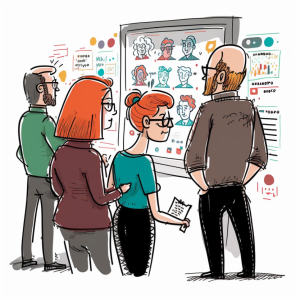Are you looking to add some interactivity to your next design thinking workshop? If so, follow these 9 simple rules and you’ll be leading interactive workshops like a pro in no time. From prep work to execution, these tips will help ensure your success. So let’s get started!
1. Pick the right format
When deciding on a format for your workshop, consider what type of interaction you want to encourage between participants. Do you want participants to be working together in small groups? Do you want them to be moving around the room? Do you want them to be sitting in a circle? There are no right or wrong answers, but some formats are better suited for certain types of activities than others.
2. Keep it focused
It can be tempting to try to pack too much into a workshop, but it’s important to keep the focus narrow. Choose one or two topics that you want to explore in depth and stick to those. Trying to cover too many topics will only lead to confusion and frustration among participants.
3. Make it hands-on
People learn best by doing, so make sure your workshop is heavy on activities and light on lectures. Workshop participants should be spending the majority of their time working on exercises and projects, not listening to you talk.
4. Encourage collaboration
Workshops are an excellent opportunity for people to learn from each other, so make sure to encourage collaboration among participants. Pair people up for activities whenever possible, and create opportunities for group discussion and brainstorming.
5. Keep it interactive
In addition to encouraging collaboration, it’s also important to keep the overall tone of the workshop interactive. This means avoiding long lectures and instead opting for short presentations followed by questions and discussion and many many design thinking activities. It also means making sure there are plenty of opportunities for participants to ask questions and share their own ideas and experiences.
6. Make it fun
Learning should be enjoyable, so make sure your workshop is fun! This doesn’t mean you need to turn it into a party, but adding a few elements of fun will help keep participants engaged and motivated. For example, you could incorporate games or icebreakers into the beginning of the workshop or offer prizes for participation throughout.
7. Set clear objectives
Before starting your workshop, take some time to clearly define its objectives. What do you hope participants will get out of it? What specific knowledge or skills do you want them to walk away with? Having a clear understanding of your objectives will help you stay focused throughout the planning process and ensure that your workshop is successful.
8. Plan ahead
Don’t wait until the last minute to start planning your design thinking workshop! The more time you have to plan, the better prepared you’ll be when things don’t go according to plan (and they almost always don’t). Give yourself plenty of time to develop activities, create materials, and promote the event so that everything runs smoothly on the day of the workshop.
9. Be flexible
Even if you’ve planned everything down to the last detail, there’s a good chance things will not go as planned during your workshop. That’s why it’s important to be flexible and adaptable on the fly. If an activity isn’t working as well as you had hoped, ditch it and move on to something else. And if things start running behind schedule, don’t hesitate to cut some content so that you can stay on track. The most important thing is that participants are learning and having a good time, so don’t sweat the small stuff!

Workshops can be a great way to achieve common goals, but only if they’re done right. Make sure your next design thinking workshop is short and sweet, with a clear purpose. Get everyone involved by encouraging creativity and break up the day with some fun activities. And lastly, don’t forget to be prepared with all materials ready ahead of time. Follow these tips and your workshop is sure to be a success!





